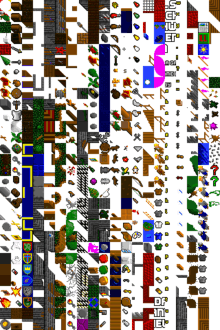Tile-based video game

A tile-based video game is a type of video or video game where the playing area consists of small rectangular, square, or hexagonal graphic images, referred to as tiles. The complete set of tiles available for use in a playing area is called a tileset. Tiles are laid out adjacent to one another in a grid; usually, some tiles are allowed to overlap, for example, when a tile representing a unit is overlaid onto a tile representing terrain. Tile-based games usually simulate a top-down or "2.5D" view of the playing area, and are almost always two-dimensional.
Tile-based games are not a distinct video game genre; rather, the term refers to the technology a game engine uses for its visual representation. For example, Ultima III is a role-playing video game and Civilization is a turn-based strategy game, but both use tile-based graphic engines. Tile-based engines allow developers to create large, complex gameworlds efficiently and with relatively few art assets.
History
The tile-map model was introduced by the Namco Galaxian arcade system board in 1979.[1] Early video game consoles such as the Intellivision were designed to use tile-based graphics, since their games had to fit into video game cartridges as small as 4K in size. Regardless of their outward appearance or game genre, all Intellivision games are tile-based.
Early tile-based games shipped with pre-constructed levels or generated levels at game startup (for example, with SimCity and Civilization) or on the fly (as with Roguelike games). A feature of tile-based games is that they allow for the creation of easy to use map editors, and many tile-based games come with an editor that allows players to construct their own levels. While completed levels for a game may hide all traces of tile-based technology, use of an editor for such a game strips away all polish and reveals a game's tile-based framework.
Most early tile-based games used a top-down perspective. The top-down perspective evolved to a simulated 45-degree angle, seen in 1994's Final Fantasy VI, allowing the player to see both the top and one side of objects, to give more sense of depth; this style dominated 8-bit and 16-bit console role-playing games. Ultimate Play The Game developed a series of video games in the 1980s that employed a tile-based isometric perspective. As computers advanced, isometric and dimetric perspectives began to predominate in tile-based games. Notable titles include:
- Ultima Online, which mixed elements of 3D (the ground, which is a tile-based height map) and 2D (objects) tiles
- Civilization II, which updated Civilization's top-down perspective to an "isometric" (more accurately described as dimetric) perspective.
- The Avernum series, which remade the top-down role-playing series Exile with an isometric engine.
Hexagonal tile-based games have been limited for the most part to the strategy and wargaming genres. Notable examples include the Sega Genesis game Master of Monsters, SSI's Five Star series of wargames, the Age of Wonders series and Battle for Wesnoth.
Some entirely 3D games have been tile-based; one notable example is the Neverwinter Nights series from BioWare. Other games, like side-scrollers, are technically also tile-based (that is, the playing area is made up of graphic tiles), but are normally not referred to as such. Lode Runner is an example.
Tile set

A tile set (sometimes called a sprite sheet) is a collection of smaller images called tiles (typically of uniform size) which have been combined into a single larger image. Tile sets are often used in 2D video games to create complex maps from reusable tiles within the set. When a tile set based map is displayed, the tiles that are stored within it are used to reassemble the map for display. This technique is seen in games designed to run on portable systems such as Nintendo's Game Boy Advance system or a cellular phone. Using tile sets reduces the amount of system memory required to display maps since it allows for the same tiles to be reused multiple times in a map. It also reduces amount of artwork needed for individual maps since many different ones can be created from the same tileset. In order for maps made from tile sets to appear more distinctive, games typically display them with a different tile set for each unique environment.
This method is implemented in many 2D games as well as applications meant for game creation, such as RPG Maker, Game Maker, Construct, Godot, and Tiled.
List of tile-based video games
Other examples of tile-based video games include:
- Aligasia-Online
- City Building Series
- Civilization series
- Chip's Challenge
- Dig Dug, Bomberman and Super Boulder Dash, all of which highlighted the presence of tiles to create a scrolling video game version of a board game
- Dragon Quest series up until Dragon Quest VI
- Dweep Gold, the only 3D tile game, in which you can inflate and float over walls.
- Dynasty Tactics series
- Final Fantasy series up until Final Fantasy VI
- Fleet, Space MMO
- Heroes of Might and Magic series
- Galaxian
- Glest
- Gold Box RPG series (also have a first-person display mode)
- Knytt series
- Lord Word Worm
- Neverwinter Nights, the first graphical MMORPG
- Pac-Man
- Most Pokémon games
- SimCity
- Tactical role-playing games such as Shining Force, Ogre and Final Fantasy Tactics
- The Ancient Art of War
- Tibia (video_game) It is one of the oldest MMORPGs.
- Ultima series (some games also have a first-person display mode)
- Utopia
- Wars series
